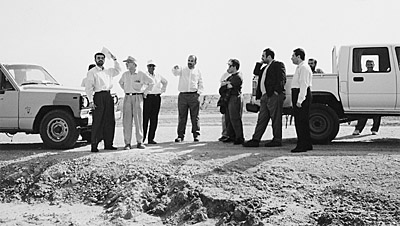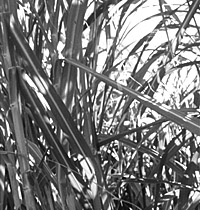


M. K.C Alexander, phytopatologiste indien, a entrepris une série de missions CTPD en Iran pour conseiller ce pays dans l'application d'un programme de création d'installations de quarantaine pour la canne à sucre et la mise au point de variétés de ce végétal axé plus particulièrement sur la résistance aux ravageurs. Ancien directeur du Sugarcane Breeding Institute (ICAR) de Coimbatore (Inde), M. Alexander s'est rendu à trois reprises pour des missions de trois semaines dans la Province du Khouzistan dans le sud-ouest de l'Iran, en 1998 et 1999. L'ambitieux projet de coopération technique visait à introduire de nouvelles variétés de canne à sucre en Iran, concevoir et appliquer un programme de mise en place d'installations de quarantaine visant à protéger le précieux plasma germinal importé à des fins de recherche, et créer des compétences et des moyens en matière de gestion dans le domaine de la protection des végétaux. Le projet contribue de manière considérable à l'objectif à plus long terme de l'Iran, qui est celui de réduire les importations de sucre afin d'atteindre son autosuffisance en sucre.
K.C. Alexander, fitopatólogo indio, con una amplia experiencia en su campo, realizó una serie de misiones de CTPD en Irán para asesorar al país sobre cuarentena de la caña de azúcar y el desarrollo de variedades, con especial atención a la resistencia a las plagas. El Dr. Alexander, ex Director del Instituto de Mejoramiento de la Caña de Azúcar (ICAR) en Coimbatore, India, realizó tres misiones, de 21 días de duración, en la provincia de Khuzestán, en el sudoeste del Irán, durante 1998 y 1999.
El ambicioso proyecto de cooperación técnica, pretendía introducir nuevas variedades de caña de azúcar en Irán, iniciar un programa de mejoramiento de la caña de azúcar en el país, organizar y aplicar un programa de cuarentena para la importación de germoplasma con fines de investigación, y desarrollar conocimientos de gestión y capacidad para protección vegetal. El proyecto contribuirá considerablemente al objetivo a largo plazo de Irán de reducir las importaciones de azúcar y lograr la autosuficiencia en la producción azucarera.
![]()
K.C. Alexander, an Indian plant pathologist with extensive experience, undertook a series of TCDC missions to Iran to advise the country on sugar-cane quarantine and variety development, with particular emphasis on pest resistance. Formerly director of the Sugarcane Breeding Institute (ICAR) in Coimbatore, India, Alexander completed three 21-day missions in Khuzestan Province of southwestern Iran during 1998 and 1999.
The ambitious technical cooperation project aimed to introduce new sugar-cane varieties into Iran, initiate a sugar-cane breeding programme, establish and implement a quarantine programme for the import of germplasm for research purposes, and develop management expertise and capacity in plant protection. The project will contribute significantly towards Iran's long-term objective of reducing sugar imports and achieving self-sufficiency in its sugar production.
At present, Iran produces approximately 750 000 tonnes of sugar annually; however, it consumes about 2 million tonnes each year, a figure which is likely to

K.C. Alexander and members of the project management team discussing ways of improving sugar-cane production in Khuzestan Province, Iran |
The sugar-cane industry, which is concentrated in southern Iran, currently produces about 250 000 tonnes of sugar each year. A total of 125 000 ha will have been planted in the current expansion phase of the government programme, which aims to boost Iran's sugar-cane output to about 1 million tonnes per year. Many of Iran's existing sugar-cane varieties and crop management techniques have not been updated and there is an urgent need to introduce new varieties to maintain yield levels.
During his missions under the TCDC/TCCT Experts Programme, Alexander assessed local expertise, facilities, phytosanitary legislation and regulations and sugar-cane pests in the field. He made a number of practical recommendations which Iran needs to implement if it is to succeed in introducing and breeding

K.C. Alexander (centre) with local project staff examining new, improved, disease-free sugar-cane varieties in Khuzestan Province, Iran |
A range of pests and diseases were found to be present in Iran, with possibly two new diseases that will be confirmed through laboratory tests in the near future. The major disease affecting sugar cane is smut, particularly in the new shoots (ratoons), and its spread is helped by mechanized cultivation. In the most susceptible variety, smut has been noted to infect 30 to 40 percent of the plants with a subsequent halving of yield. A programme for pest-resistance breeding, including sugar-cane mosaic virus, has been initiated. Increased capacity is urgently needed in the research centre's pathology laboratory: its programme of work needs to be strengthened and its staff increased and trained to support a disease-resistance breeding programme. A clean seed programme has been designed and implemented for commercial planting, with very encouraging results. This programme will continue to be developed and expanded.
Increased capacity is urgently needed in the research centre's pathology laboratory: its programme of work needs to be strengthened and its staff increased and trained to support a disease-resistance breeding programme. A clean seed programme has been designed and implemented for commercial planting, with very encouraging results. This programme will continue to be developed and expanded.
In addition to the valuable work undertaken by the Indian plant pathologist, two sugar-cane breeders (under the TCDC programme) have recently undertaken one-month consultancies at the Sugarcane Research Centre in Iran. One of them, an Iranian, had spent just over two months training in breeding techniques at the Sugarcane Breeding Centre (INICA) in Cuba. This training concentrated on induced flowering of sugar cane and crossing breeding lines.